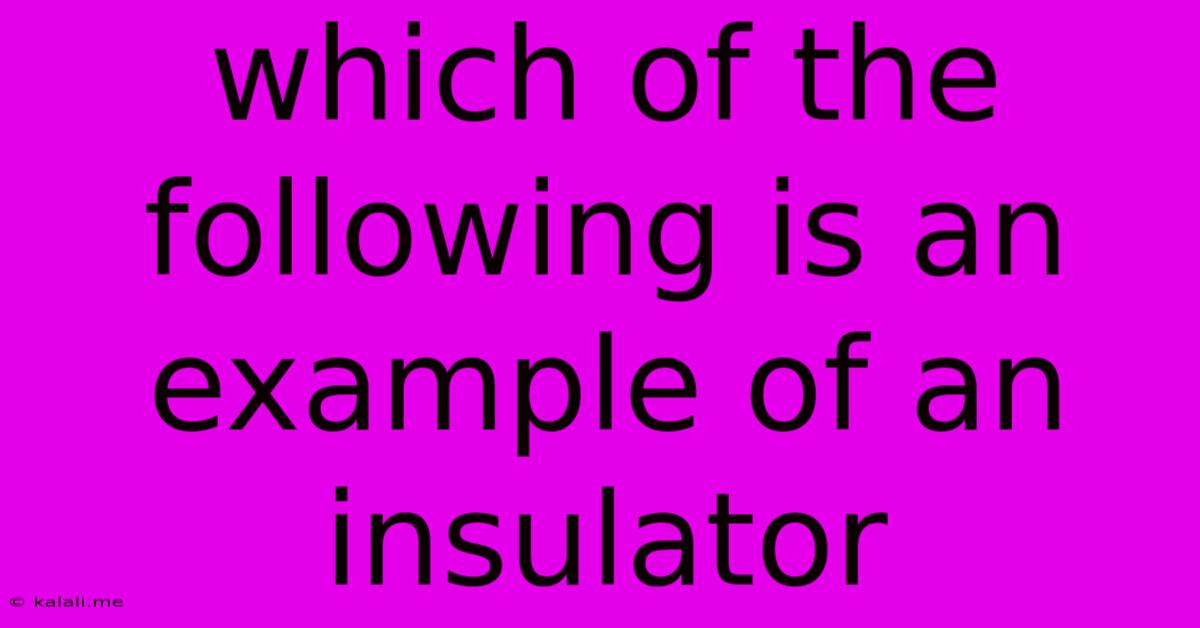Which Of The Following Is An Example Of An Insulator
Kalali
Jun 15, 2025 · 3 min read

Table of Contents
Which of the Following is an Example of an Insulator? A Deep Dive into Electrical Insulation
This article will explore the concept of electrical insulators and provide clear examples, helping you understand which materials effectively prevent the flow of electricity. We'll also delve into the properties that make a material a good insulator, and discuss some common applications. Understanding insulators is crucial in many fields, from electrical engineering to everyday household safety.
What is an Electrical Insulator?
An electrical insulator is a material that resists the flow of electric current. Unlike conductors, which readily allow electrons to move freely, insulators impede this movement. This resistance is due to the atomic structure of the material; insulators have tightly bound electrons that are not easily dislodged and contribute to current flow. The key characteristic is high electrical resistivity.
Properties of Good Insulators
Several properties contribute to a material's effectiveness as an insulator:
- High Resistivity: This is the primary characteristic. A high resistivity indicates a strong resistance to the flow of electric current.
- High Dielectric Strength: This refers to the material's ability to withstand a high voltage before breaking down and allowing current to flow.
- Chemical Stability: Insulators should remain stable and not degrade under various environmental conditions, such as moisture, heat, or chemicals.
- Mechanical Strength: In many applications, insulators need to be physically strong and durable to withstand mechanical stress.
Examples of Insulators: Common Materials and Their Applications
Now, let's answer the question directly: many materials serve as excellent insulators. Here are a few examples:
- Rubber: Widely used in electrical wiring, gloves, and other protective equipment due to its high resistance and flexibility.
- Glass: Used in high-voltage applications, including insulators on power lines, because of its excellent dielectric strength and resistance to weathering.
- Plastics (e.g., PVC, Teflon): Common in various electrical applications due to their versatility, durability, and insulating properties. Different plastics offer varying degrees of insulation strength.
- Wood: While not as effective as other materials, dry wood provides reasonable insulation and has been historically used in electrical applications. However, moisture significantly reduces its insulating properties.
- Ceramics: Certain ceramics exhibit exceptional high-temperature insulating properties, making them suitable for high-voltage and high-temperature applications.
- Air: Acts as an insulator in many situations, contributing to the safety of electrical equipment and systems. The breakdown voltage of air limits the amount of current that can flow through it.
Identifying Insulators vs. Conductors
It's important to be able to distinguish between insulators and conductors. Conductors, such as copper and aluminum, have low resistivity and readily allow electric current to flow. Insulators, in contrast, have high resistivity and impede the flow of current.
Conclusion: Understanding the Importance of Insulators
Insulators play a vital role in ensuring safety and functionality in electrical systems. From protecting us from electric shock to enabling the efficient operation of high-voltage equipment, their properties are indispensable. Understanding the characteristics and applications of different insulators is essential in various fields, highlighting their crucial role in modern technology and everyday life. Remembering the examples provided – rubber, glass, plastics, wood, ceramics, and air – will provide a solid foundation for understanding this critical aspect of electrical engineering and physics.
Latest Posts
Latest Posts
-
Differentiate Between Leading Strand And Lagging Strand
Jun 16, 2025
-
Which Of The Following Sentences Are Correct
Jun 16, 2025
-
What Are The Differences Between Representative Democracy And Direct Democracy
Jun 16, 2025
-
Admission Requirements For Tarleton State University
Jun 16, 2025
-
What Is The Factor Of 86
Jun 16, 2025
Related Post
Thank you for visiting our website which covers about Which Of The Following Is An Example Of An Insulator . We hope the information provided has been useful to you. Feel free to contact us if you have any questions or need further assistance. See you next time and don't miss to bookmark.